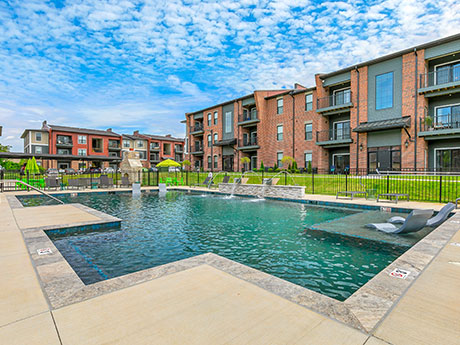Fueled by a trifecta of favorable cap rates, an underserved apartment market and sharp increases in market demand, St. Louis is starting to gain momentum with the potential to become a new multifamily hotspot. As investors and developers take note, capital that typically has been focused in higher growth markets on the coast and cities like Chicago and Nashville is starting to flow into the Gateway City.
The fruit of these investments is now coming to market. Despite 20-plus percent increases in construction costs, 24 percent more units — 2,057 total — were built in 2021 compared with St. Louis’ five-year annual average. Nearly 4,000 additional units are under construction in the St. Louis region.
Population, personal income and job growth are the key economic drivers of multifamily unit demand. In 2020 and 2021, all three of those markers are finishing on the upside in St. Louis after pandemic dips.
Employment growth is particularly promising. After slight employment declines over the last five years, St. Louis employment has grown at an average annual rate of 2.7 percent for the last four quarters. CBRE forecasts positive growth of 2 percent for the next two years and 0.8 percent for the next five years.
Four fundamental demographic shifts are also driving the spike in demand for rental housing. All signs indicate that St. Louis is poised for strong and lasting multifamily development growth.
Untapped market
With the cost of housing 27 percent below the national average, St. Louis’ rental market was long neglected and multifamily options remained relatively low as developers focused on building single-family homes. Sister markets like Nashville or even Kansas City have been booming for years, adding new multifamily products to their regions, but St. Louis has remained underserved.
As housing supply drops, home prices rise and people want more lifestyle flexibility. All of a sudden, multifamily demand is growing, but the region is behind the curve. Opportunity resides in this market gap.
Population shifts
Though St. Louis’ overall population levels dropped year after year between 2016 and 2020, the population is shifting within the region and driving localized demand.
Movement west into St. Charles County creates multifamily opportunities where land is readily available. The county is attractive to St. Louis city and county residents because of reduced traffic, amenities and shopping, spacious land for modern developments, corporate anchors and appealing to some are comparatively lax pandemic restrictions.
This westward expansion has been steady for decades. The St. Charles County population base increased 12.4 percent between 2010 and 2021, according to the U.S. Census. Signaling rental demand, St. Charles County’s vacancy rate dropped to 2.4 percent in the third quarter of 2021, well below the St. Louis MSA rate of 3.6 percent, which is also at a comparative low.
Capstone corporate and community construction projects are creating other regional pockets of high growth. The future St. Louis Major League Soccer stadium and the $1.7 billion National Geospatial-Intelligence Agency headquarters are spawning development in the surrounding districts in St. Louis City. Newer corporate facilities for brands like Pfizer, Reinsurance Group of America and Bunge have increased demand in Chesterfield and Western St. Louis County.
Increased flexibility
Uncertainty correlates with flexibility, and multifamily living absolutely supports flexibility. Accelerated by the pandemic, the flexible lifestyle and live/work balance that people increasingly want is more viable. Newer multifamily communities are responding with higher-cost, short-term leases; units designed with a workspace; and community business centers. People also are increasingly attracted to the convenience, community and safety of multifamily developments.
Development design shifts
New developments are being designed more intentionally to appeal to a wider variety of tenants, including higher earners, who desire a low-commitment, high-flexibility and high-amenity lifestyle.
The luxury Mia Rose Holdings developments we are building in St. Charles County will have high-quality finishes comparable to a custom home, outdoor spaces and walking trails, pet-friendly policies and recreational amenities that people crave.
The average income at the Grand Central Modern Apartments at The Junction community we developed in Wentzville is more than $80,000. Tenants include young professionals who want to save money, enjoy inclusive amenities and have mobility before purchasing a home. Residents age 35 to 45 seek a high-end, short-term living situation while their home is built or home prices stabilize and inventory increases. Recently retired tenants want fewer responsibilities than a house offers and the ability to easily pick up and travel. They also love the community aspect and amenities.
Multifamily residents nationwide increasingly include those experiencing personal transitions, from job changes to divorce, triggered by the pandemic who need a quality, intermediary housing solution.
While construction inflation has curbed some regional multifamily projects, rent increases are starting to come online, making it viable for nervous developers to move forward. CRBE forecasts 5.7 percent rent inflation in 2022. Current and projected high absorption rates, low vacancy rates and the quick leasing of developments indicate the St. Louis multifamily market has the capacity for substantial growth in the years to come.
Tom Kaiman is president of Mia Rose Holdings LLC. This article was originally published in the January 2022 issue of Heartland Real Estate Business magazine.



